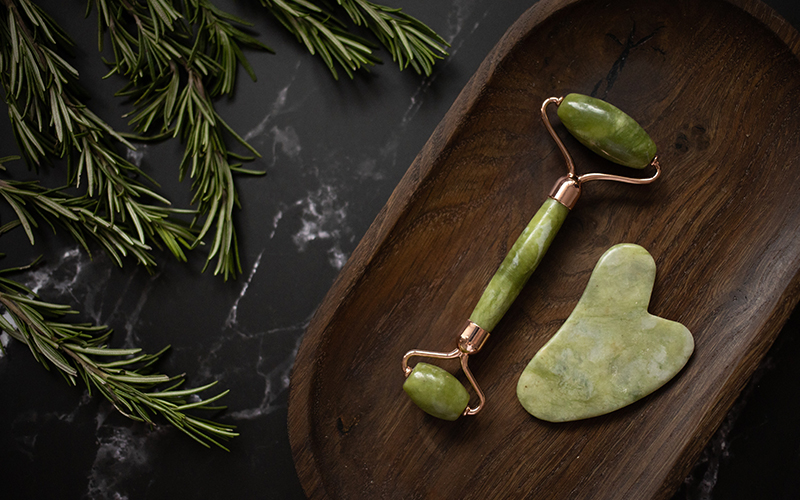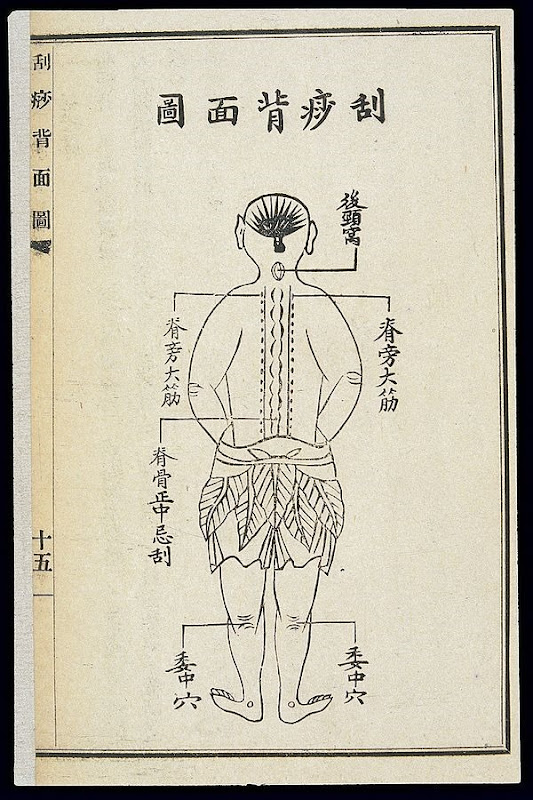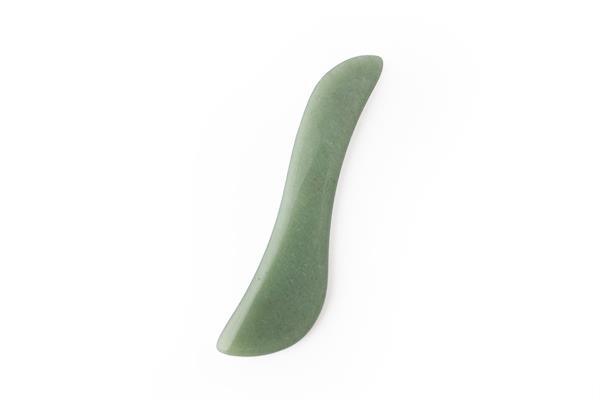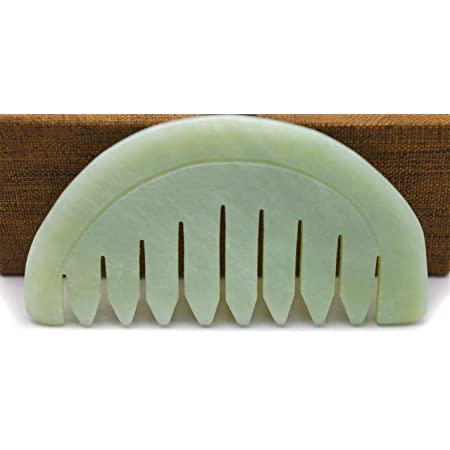
Gua Sha (pronounced gwa-shah) is a tool, or tools, used to scrape the skin to promote circulation. Traditional Chinese Medicine (TCM) utilized Gua Sha tools thousands of years ago to increase blood circulation and heal the body. Today, the practice continues to evolve into a sought-after addition to people’s beauty regimen to tone and tighten skin. In this blog, we will explore the origins of Gua Sha, its benefits, and the tools and techniques used for this ancient skin practice.
Gua Sha is a traditional Eastern and Southeast Asian healing technique in which a smooth, credit-card-sized “board” is pressed along the body’s skin; however, in more recent years, it’s been adapted for the face and neck, as well. The idea behind Gua Sha is that light pressure releases fascial and muscular tension and moves sluggish lymph fluid to tone the face.
Originally, Gua Sha was used to release different aches and pains in the body. For example, in TCM, it was commonly used on the upper back to invigorate blood flow, release heat toxins, stimulate lymphatic drainage, activate various acupressure points of the body, and stimulate an immune response bringing beneficial cells to the area.
Gua Sha works by promoting blood circulation. When you scrape the skin gently on the face or body, you’re stimulating a certain meridian point, which corresponds to an organ in the body that’s responsible for your skin’s overall health. In turn, you’re sending a signal to your body that this area needs more circulation.

Pictured: Back-view illustration of Gua Sha treatment from Fangyi chuyan (A Modest Proposal for Epidemic Prevention) Source: Gua Sha Massage
With its origins in the treatment of abscesses in the Warring States period (475-221 BCE) of ancient China, Gua Sha has been a mainstay as a folk medicine since antiquity.
Theories of “sha” disease gradually developed based on the premise that a pathogen was to be cleared and dispersed from the body and this was combined with a scraping technique, initially involving a hemp rope rubbing method using water or sesame oil in the Yuan dynasty (1271-1368 CE).
By the Qing dynasty (1644-1912 CE), the method of scraping had become more precise and expanded towards the entire body. A working framework for the treatment of sha was also developed at this time which enabled a wider application of scraping and included instructions for headaches, numbness of the face, and head shaking.
It was not until the Song dynasty (960-1279 CE) that anything resembling the practice of cosmetic scraping appeared, which was in the form of jade rubbing to treat facial scars. Many of the ideas behind facial Gua Sha have been influenced by traditional Chinese cosmetology, which from the Warring States and Qin and Han Dynasties, came ideas of how the human body and skin color changes are directly related to changes in people’s temperament, age, health, and qi.
Ancient doctors rarely recorded the specific methods, time, and treatment of Gua Sha but in the 20th century with the work of Jiang Jingbo and later Lu Jiru, Gua Sha was reinvigorated and an adapted, modernized style of Gua Sha therapy was promoted.1
Implementing Gua Sha into your self-care routine may offer these potential benefits:
Similar to other types of massages, gliding a Gua Sha tool across your face or body can promote microcirculation in your soft tissues, aka blood flow in small blood vessels. This increase in blood flow might help physical symptoms of inflammation like puffiness and swelling.2 The practice may also help lymphatic drainage by moving fluid away from swollen areas.3
Every year, our skin produces 1% less collagen; collagen keeps our skin strong and elastic.. Giving yourself regular Gua Sha facials can help ramp up your skin’s collagen production, thereby reducing the appearance of fine lines and wrinkles.4
Gua Sha can increase the efficacy of the skincare you’re already using. If you apply your moisturizer or serum and then give yourself a massage, the Gua Sha tools helps push the product deeper into your skin. This can help your serum absorb better and allow you to experience the full benefits of the formula.
If you feel the aches and pains from uncomfortable work posture or constant scrolling, a Gua Sha body massage might help. In a small 2014 study involving 60 regular computer users with neck and shoulder pain, researchers found that Gua Sha helped reduce pain and improve range of motion.5 Individuals in a small 2011 study also reported that Gua Sha helped reduce neck pain when compared with people who used heating pads.6
If you’re dealing with migraines or headaches, Gua Sha might help relieve pain and tension in your head and neck. A 2007 case study of a 72-year-old woman reported that Gua Sha helped relieve migraine symptoms over a 14-day period.7
Gua Sha’s ability to promote blood circulation might also help move the buildup of lactic acid that accumulates from your workouts. In a small 2017 study involving 65 male weightlifters, people who had Gua Sha treatments reported that lifting weights was easier post-treatment. Researchers concluded that Gua Sha might also help speed up muscle recovery and be a potential alternative to other sports recovery methods.8
Tourette syndrome is a condition that affects the nervous system and causes sudden involuntary movements or sounds. While Gua Sha is not a miracle cure, limited research shows it might help reduce symptoms when combined with other treatments.
A 2017 case study of a 33-year-old man found that a combination of Gua Sha and other therapies appeared to reduce his Tourette syndrome symptoms. 9
A small 2017 study involving 80 perimenopausal women found that people who had Gua Sha treatments for 8 weeks experienced fewer symptoms compared with the control group receiving only traditional therapy. 10
Some of the most common Gua Sha tool shapes are:

Pictured: Wand Gua Sha tool Source: Eastern Currents
This long, slender tool has 2 pointy ends that are best to use for specific areas where you want to apply pressure and relieve tension in the body. These areas are primarily in the hands, feet, laterals, back, neck, and shoulders. The challenge with this shape is the limited maneuverability around the face and smaller areas of the body.
If you’re interested in adding this tool to your regime, check out the LEOSENSE Gua Sha Bian Stone Wand Tool.

Pictured: Dolphin Gua Sha tool Source: DH Gate
This tool shape is one of the most popular and commonly purchased Gua Sha tools available on the market. It’s easy to hold due to its small size and is perfect for contouring different areas of the face including the jawline, nose bridge, chin, and under-eye area.
While the heart-shaped tool is great for the face, neck, and hands, it might be less effective to use in other parts of the body as its edges are not long enough to hold onto, and therefore less workable for applying firmer pressure.
If you’re interested in adding this tool to your regime, check out the MEEKU Gua Sha Stainless Steel Dolphin Tool.

Pictured: Spoon Gua Sha tool Source: Amazon
A Gua Sha spoon is a sculpting tool that helps you target acupressure points along your face and neck to gently release any muscle tension. Its spoon-like shape helps to target smaller areas as well as harder-to-reach areas like those around the nose and eyes.
If you’re interested in adding this tool to your regime, check out the Top Sewing Gua Sha 100% Jade Spoon Tool.

Pictured: Comb Gua Sha tool Source: Amazon
This shape is exactly what it sounds like: a Gua Sha scraper equipped with comb-like prongs. On one side of this tool, you have the classic curved edge, perfect for a facial treatment. On the opposite side, the stone is shaped into a comb so you can give your scalp a nice, deep massage.
If you’re interested in adding this tool to your regime, check out the FORUHEALTH Gua Sha Jade Comb Tool.
Here’s a look at the most common materials used in Gua Sha:
Once you choose the perfect shape and material, you can start using your Gua Sha tool every day or at least two to three times a week. To prevent any rashes or irritation when doing a Gua Sha massage, make sure to always use a facial oil first.
After using your Gua Sha tool, be sure to clean it with soap and warm water.
Always begin with your neck to release tension and assist with lymph drainage. Repeat each step three to five times. For a more detailed look at this technique, you can check out this video.

The golden rule of Gua Sha is to always apply facial oil before using your stone. You need enough slip so that the tool can easily glide across the contours of your face — without it, you can pull or tug at your delicate skin.
The Humanist Beauty Herban Wisdom® Facial Oil is a high-vibrational facial oil that will compliment your Gua Sha routine perfectly. This exceptional formula is a powerful skin treatment fusing clean plant nutrients rich in antioxidant, adaptogenic, rejuvenating, and moisturizing properties.
Just a few drops incorporated into your own Gua Sha ritual can help visibly recharge skin to appear calm and balanced, radiating with a gorgeous natural glow.
You can shop the Humanist Beauty Herban Wisdom® Facial Oil here.
http://en.chinaculture.org/info/2013-04/25/content_456628.htm [1]
https://www.sciencedirect.com/science/article/abs/pii/S1550830707001772?via%3Dihub [2]
https://www.mdpi.com/2077-0383/9/11/3678/htm [3]
https://blog.sidekicktool.com/gua-sha-wrinkles/ [4]
https://he01.tci-thaijo.org/index.php/ams/article/view/66337 [5]
https://academic.oup.com/painmedicine/article/12/3/362/1829149?login=false [6]
https://www.karger.com/Article/Abstract/107731 [7]
https://www.sciencedirect.com/science/article/pii/S0254627217300262 [8]
https://www.sciencedirect.com/science/article/pii/S200529011630125X?via%3Dihub [9]

Disclaimer: Statements on this website have not been evaluated by the FDA. These products are not intended to diagnose, mitigate, treat, cure, or prevent any disease, nor are the products intended to affect the structure or any function of the body of man/woman or other animals. CANNABIDIOL USE WHILE PREGNANT OR BREASTFEEDING MAY BE HARMFUL. KEEP OUT OF REACH OF CHILDREN. Humanist Beauty Herban Wisdom products include hemp extract that contain less than 0.3% THC. Products containing CBD or THC are not to be used by or sold to persons under the age of 21.
We don’t retouch the skin of the model humans shown on this website. Keepin’ it real.